"Image du Monde" Challenge : Bringing Scholars Together in Uncertain Times
Engaging in transcription and digital edition of medieval manuscripts can help create and maintain international communities of scholars, especially at times when direct contact with colleagues is limited, travel plans have been suspended and general feeling of uncertainty is palpable, such as the current COVID crisis. For our new blogpost, Laura Morreale answered TVOF's questions about Part I of the collaborative crowdsourcing project Image du Monde Challenge, that took place between 25 September - 9 October 2020 - and about her hopes for the future of such initiatives.
Laura will be hosting a similar transcription event this November during the Schoenberg Symposium on Manuscript Studies in the Digital Age, where attendees will prepare an edition of the Pelerinage de Damoiselle Sapiance. Spots for this short term event are still open.
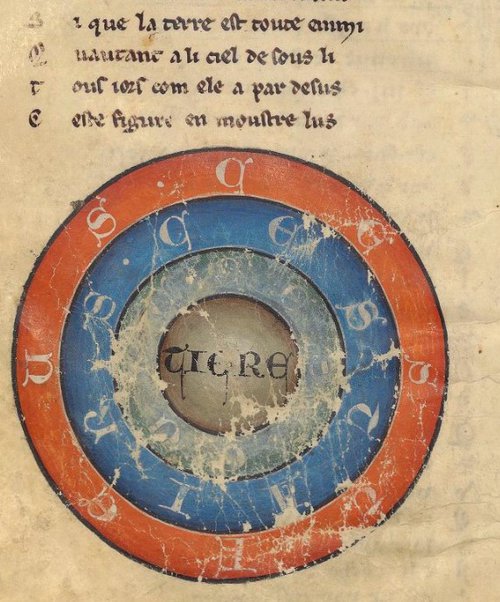
Diagram of the Earth. BnF fr. 14964, f. 31v. Source: Gallica.
What is the Image du Monde Challenge?
The Image du Monde Challenge is a two-part crowdsourcing event that provides the tools, structure, and a designated time frame for participants to transcribe five different manuscript versions of Gossuin de Metz’ early thirteenth-century treatise, the Image du Monde. The text is written in verse and addresses topics such as cosmology, geography, philosophy, and political theory, and exists in over sixty copies in its first redaction. The text was rewritten a second time, revised further as a prose text, and translated many times over to accommodate new audiences. Several digital copies of the first redaction are available online, and these materials are posted in a transcription environment that allows for the work to occur both quickly and collaboratively.
The Challenge brings together five 10-member teams to transcribe one half of the text in each two-week event. Teams are led by a captain or two co-captains whose job is to organize and support team members as they transcribe and review portions of the text, and to create a transcription statement that reflects the scribal practice of each manuscript. Once the entire selection is transcribed, team captains review the edition rules established by their teammates, check the new version according to these standards, and provide a final editorial sign-off, all within the assigned two-week period.
Transcriptions and all associated materials, including the team-written statement, an activity log, and four team updates, are then submitted to a panel of three judges. Submissions are judged on three criteria; speed, accuracy, and collaboration. Judges then announce a winner, although for now the prize is nominal, for glory only!
How did the idea of the Image du Monde Challenge come about?
The Image du Monde Challenge is the third such transcription event that Ben Albritton and I have organized since summer 2020. The first two events, which were held in May and July and focused on an Italian schoolboy geography by Goro Dati called La Sfera, were so overwhelmingly successful that we wanted to bring the concept to the medieval francophone community as well. Although the text is a bit longer than La Sfera and presents a different set of challenges, we received a good deal of positive feedback and evidence of deep engagement with both the material and with fellow Image du Monde participants.
The real motivation to organize transcription events in the first instance was to find some way to come together around materials and activities so many of us are passionate about. Even though none of us can gather in person this year at the annual conferences where we most often meet, the transcription challenges have given participants an excuse to come together for a common cause, and maybe be part of a little good-natured fun.
What determined the choice of From the Page as the platform/software for collaborative work?
I have used FromThePage in my own research for years, and I value it especially for how easily new users can sign on and begin to contribute. Although the platform does not replicate all of the features of medieval manuscripts, it was purpose-built to facilitate collaborate workflows like the one we designed for the Image du Monde and La Sfera Challenges.
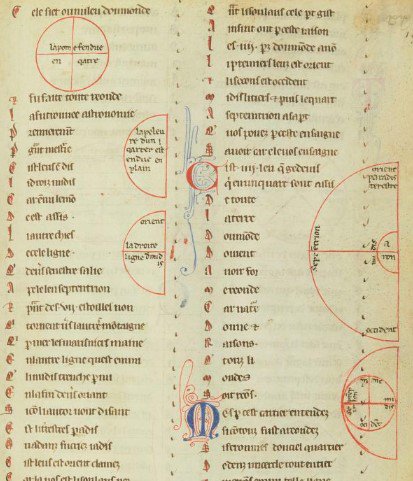
Diagrams. BnF fr. 2173, f. 19r. Source: Gallica.
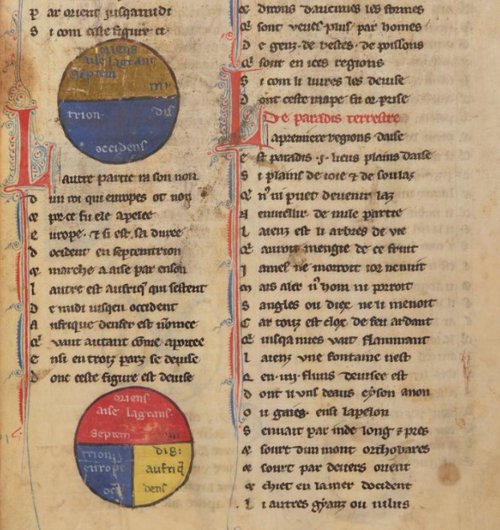
Diagrammatic maps of the regions of the world and of the continents. BnF fr. 24428, f. 13v. Source: Gallica.
How was the work organised (workflows, communication tools)?
Each transcription event begins with a challenge organizer (I have filled that role in for these first events). The role of the challenge organizer is to act as a host to all the participants, to identify willing captains, facilitate team building, and respond to any concerns that come up over the course of the challenge.
Team captains are charged with building their own 10-person teams, either from a list of previous participants or from among their own networks. The challenge coordinator also promotes the event on social media, and recruits participants from there as well.
Each team is assigned a manuscript. Digital images of the manuscript are uploaded to the transcription portal and a link posted on the team page. Once the competition begins, teams must meet (virtually) to divvy up the materials and strategize according to the difficulties presented by their individual manuscripts. Each folio must first be transcribed by one team member, reviewed by a second, then given editorial sign-off by a team captain. The completion dates for each task are recorded on the project log, which is also linked on the team page. While some teams chose to communicate during the event solely through the notes section of the team log, others use platforms like Slack or Twitter to ask tough transcription questions or to set the norms for the transcription statement. Team members will also comment on the progress of their transcription or on other teams’ activities and will post discoveries on their team’s page or on social media. It’s fun to be part of the community, to see where others are having difficulty or are thriving.
What are the biggest challenges and rewards for a co-captain of an international/interdisciplinary transcription team?
Certainly, the biggest challenges are those we are all facing in this COVID moment. Whether it is coming to terms with time zone changes that our instantaneous meetings have now forced us to confront or dealing with the unexpected time shortages some participants face as a result of unforeseen events or stressors in this new lockdown world, things do not always go as planned. Because the most important goal of these events is to enjoy each other and the skills we share, most of these difficulties have been met with enormous good will and understanding.
And curiously, it is this good will that is also one of the most gratifying parts of these events. Networks are built, old friends reconnect, and new friends are made, and many, many participants surprise themselves with the amazing abilities they never knew they had. It’s great. I am also very honoured when I realize that the Image du Monde alone engaged over 50 scholars at once, bringing us and all our combined skills together to accomplish one task (see Tamsyn Mahoney-Steel’s reflection on this at the bottom of Team 2’s page). It’s quite touching that so many put their faith in a project of our own creation.
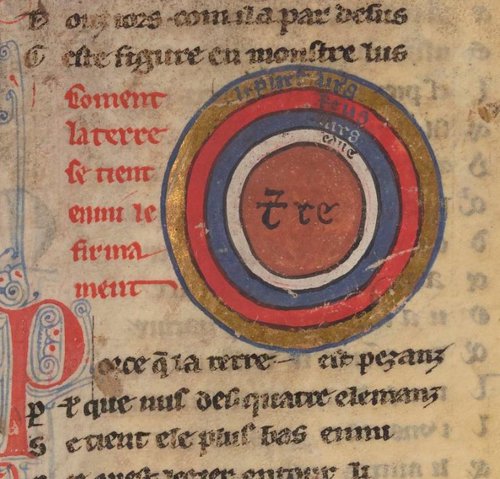
Diagram representing the arrangement of the four elements. BnF fr. 24428, f. 12r. Source: Gallica.
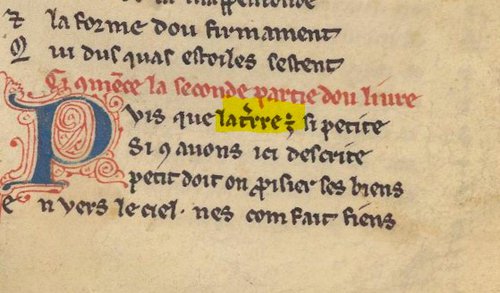
Abbreviation for “t[e]rre” (or “t[er]rre”?). BnF fr. 14964, f. 36r. Source: Gallica.
What were your team’s most interesting eureka moments during the two-week challenge?
Team 1 was a wonderful mixture of challenge veterans and newcomers. As we were deciding on the best way to represent the expanded abbreviations in the text, one of our team members remarked that traditional transcription methods existed primarily to faithfully reproduce what was found in the manuscript, since most readers would never be able to see it in person. However, since we now have an image of the manuscript page posted alongside, transcribers have different responsibilities to their readers and to the manuscript itself. Although we are all comforted by the way we traditionally engage in textual criticism, those norms will change and perhaps become outdated along with technologies we now use, and I found this particularly helpful as we find commonalities between digital and traditional ways of working. Plus, there were some great conversations about elephants, whether we should expand the abbreviation “diex,” and how many r’s there are in terrre.
What are your hopes for the second phase of the challenge, the outputs of the project and for the future of such collaborative initiatives?
I’ll be interested to see how the second part of the challenge goes, since each team will already have made decisions about the transcription norms for their particular manuscript. I hope this means that participants will take more time to engage with the text itself, and perhaps to write up a few blog posts on the discoveries they find. The updates and small reflection pieces on the team pages for this round were amazing works of scholarship in themselves, but I am always ready to hear the ways a text or manuscript inspires or intrigues those who interact with it. It’s one of the greatest things about being a medievalist, I find.
I hope to find a way to use the scholarship produced during all of these challenges in second phase of analysis, whether that means collating witnesses transcription and creating a traditional stemma codicum, tagging the text for geographic data, creating an automated index (which FromThePage does easily), or even translating the text into English for greater access. Although there are plans to house the materials in a more permanent locale that allows for easy sharing of the data, we have yet to put that in place, in large measure because the wheels are moving so slowly these days.
For the moment, however, we will be archiving all of the digital materials produced during the Image du Monde Challenge in BodoArXiv, the medieval digital repository where we have also catalogued the products of the La Sfera events. All the data from these events can be downloaded from the catalogued version, and users or participants can easily cite the project with the DOI provided.
I have great hopes for the future of transcription projects like the Image du Monde and am looking forward to passing along what we have learned to others who would like to host similar events. Ideally, we would set up a transcription challenge framework (TCF) and issue a call for projects so that scholars could bring texts of interest to their own work to the concerted attention to a group of challenge participants who would interact with their materials in a concentrated yet brief time span. Although I have enjoyed acting as Challenge Coordinator for these past events, I have learned much about the texts we have chosen, about how to implement a digital workflow, and what works when creating a virtual scholarly community, and I feel others could benefit from filling that role as well.
In the meantime, for readers of this blog, please come and join us for the second half of the Image du Monde Challenge, which will take place in early January 2021. We’d love to have you come and play with us!
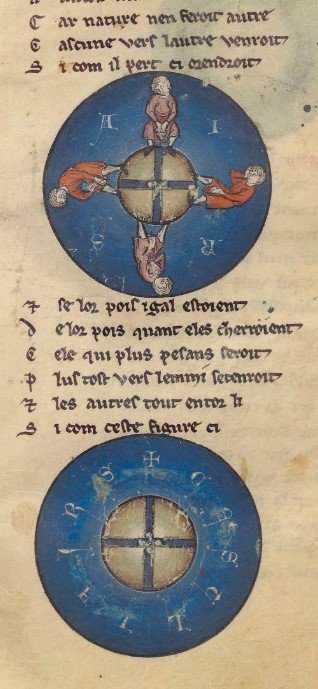
Diagrams of the Earth. BnF fr. 14964, f. 33r. Source: Gallica.
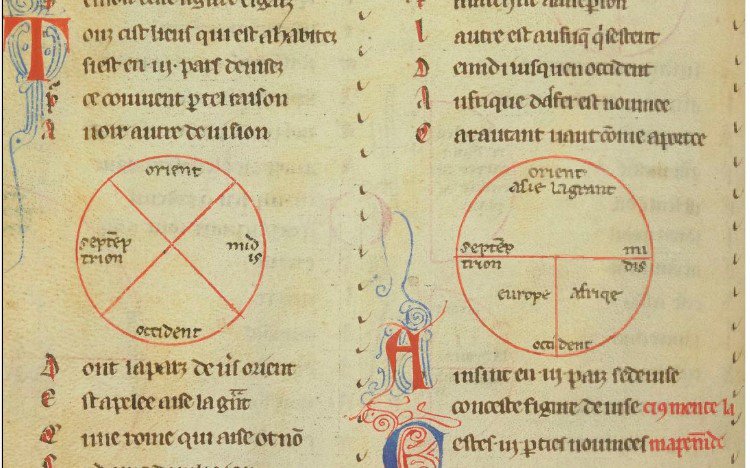
Diagrammatic maps of the regions of the world and of the continents. BnF fr. 2173, f. 19v. Source: Gallica.